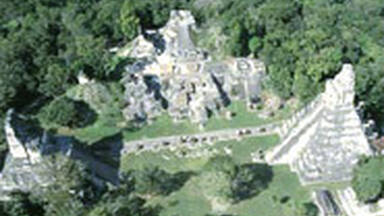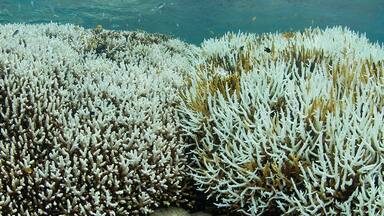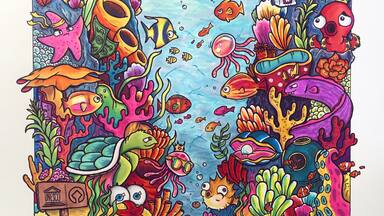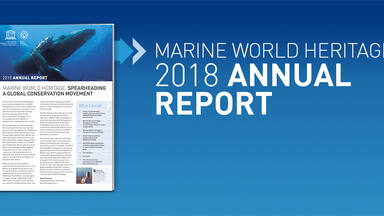Sian Ka'an
Sian Ka'an
In the language of the Mayan peoples who once inhabited this region, Sian Ka'an means 'Origin of the Sky'. Located on the east coast of the Yucatán peninsula, this biosphere reserve contains tropical forests, mangroves and marshes, as well as a large marine section intersected by a barrier reef. It provides a habitat for a remarkably rich flora and a fauna comprising more than 300 species of birds, as well as a large number of the region's characteristic terrestrial vertebrates, which cohabit in the diverse environment formed by its complex hydrological system.
Description is available under license CC-BY-SA IGO 3.0
Sian Ka'an
Dans la langue des Indiens Mayas qui peuplaient autrefois la région, Sian Ka'an signifie « origine du ciel ». Située sur la côte est du Yucatán, cette réserve de la biosphère comprend des forêts tropicales, des mangroves et des marais, ainsi qu'une vaste étendue marine traversée par une barrière de récifs. Elle abrite une flore remarquablement riche et une faune qui comprend plus de 300 espèces d'oiseaux, ainsi qu'une grande partie des vertébrés terrestres caractéristiques de la région, qui cohabitent dans la diversité des milieux formés par son système hydrologique complexe.
Description is available under license CC-BY-SA IGO 3.0
سيان كعان
في لغة هنود المايا الذين كانوا يسكنون المنطقة في الماضي، سيان كعان تعني "أصل السماء". فمحمية المحيط الحيوي هذه التي تقع على الساحل الشرقي ليوكاتان، تضمّ غابات مدارية وأشجار المنغروف ومستنقعات، بالاضافة الى مساحةٍ بحريةٍ واسعةٍ يجتازها حاجزٌ من الشُعب المرجانية. كما تحتوي على تشكيلة نباتات غنيّة للغاية وعلى مجموعة من الحيوانات تتألّف من أكثر من 300 نوع من العصافير، بالاضافة إلى جزءٍ كبيرٍ من الفقاريات الأرضية الخاصّة بتلك المنطقة والتي تتعايش مع تنوّع البيئات الذي يبتكره نظام المياه المعقّد فيها.
source: UNESCO/CPE
Description is available under license CC-BY-SA IGO 3.0
圣卡安
古代玛雅人曾在这个地区居住过,在他们的语言里,圣卡安是“天之源”的意思。这一生物保护区位于尤卡坦半岛东岸,内有热带森林、红树林和沼泽地,还有被礁石分割开的海产区。这个自然保护区为大量的动物和植物提供了生活场所,其中包括300多种鸟类,以及大量当地特有的陆地脊椎动物,这些动物在这个多样性的环境里共同生活,形成了一个复杂的水文学系统。
source: UNESCO/CPE
Description is available under license CC-BY-SA IGO 3.0
Биосферный резерват Сиан-Каан
На языке индейцев майя, которые в давние времена населяли этот район, Сиан-Каан означает «Там, где начинается небо». Биосферный резерват расположен на восточном побережье полуострова Юкатан, где произрастают тропические леса, есть мангры и болота, а также - значительная морская акватория с участком барьерного рифа. Местные флора и фауна отличаются большим разнообразием, здесь обитает свыше 300 видов птиц, встречается большое число типичных для региона наземных позвоночных, которые существуют во взаимосвязи со своеобразными местными гидрогеологическими условиями.
source: UNESCO/CPE
Description is available under license CC-BY-SA IGO 3.0
Sian Ka'an
En la lengua de los mayas que poblaban antaño la región, Sian Ka’an significa “origen del cielo”. Situada en la costa oriental de la península de Yucatán, esta reserva de biosfera abarca bosques tropicales, manglares, marismas y una vasta zona marina atravesada por un arrecife de barrera. Alberga una flora de gran riqueza y su fauna comprende más de 300 especies de pájaros y un gran número de vertebrados terrestres característicos de la región, que coexisten en el medio diversificado resultante del complejo sistema hidrológico del sitio.
source: UNESCO/CPE
Description is available under license CC-BY-SA IGO 3.0
シアン・カアン
source: NFUAJ
Sian Ka'an
Sian Ka’an betekent ‘Oorsprong van de Hemel’ in de taal van de Maya volkeren die ooit deze regio bewoonden. Het reservaat ligt aan de oostkust van het schiereiland Yucatán en omvat tropische bossen, mangrovebossen, moerassen en een zeegebied dat doorkruist wordt door een rif. Sian Ka’an vormt een habitat voor een opmerkelijk rijke flora en fauna. Die laatste bestaat uit meer dan 300 vogelsoorten en een groot aantal karakteristieke gewervelde landdieren uit de regio. Er zijn 103 soorten zoogdieren, waaronder vijf katachtigen: de jaguar, poema, ocelot, margay en jaguarondi. De dieren leven samen in de gevarieerde omgeving, gevormd door een complex hydrologisch systeem.
Source: unesco.nl
Outstanding Universal Value
Brief Synthesis
Thousands of years ago the original Maya inhabitants appreciated the exceptional natural beauty of this stretch of coastline, naming it Sian Ka´an, or “Origin of the Sky". Located on the Eastern coast of the Yucatan Peninsula in the State of Quintana Roo, Sian Ka´an is one of Mexico's largest protected areas, established to manage 528,148 hectares of intricately linked marine, coastal and terrestrial ecosystems. Along its roughly 120 kilometres of coastline, the property covers over 400,000 hectares of land ranging from sea level to only ten m.a.s.l. The property boasts diverse tropical forests, palm savannah, one of the most pristine wetlands in the region, lagoons, extensive mangrove stands, as well as sandy beaches and dunes. The 120,000 hectares of marine area protect a valuable part of the Mesoamerican Barrier Reef and seagrass beds in the shallow bays. The lush green of the forests and the many shades of blue of the lagoons and the Caribbean Sea under a wide sky offer fascinating visual impressions.
The diversity of life in Sian Ka'an is exceptional. The tropical forests are home to charismatic mammals such as Jaguar, Puma, Ocelot and Central American Tapir. The property also provides habitat for a large number of resident and migratory bird species. There is a great diversity of marine life, including the West Indian Manatee, four species of nesting marine turtles and hundreds of fish species. About a third of the property is comprised of highly diverse and productive mangrove communities, of vital importance to fisheries in the broader region. Hundreds of forested islands, locally known as "Petenes", emerge from the flooded marshes, some reaching over a kilometre in diameter. A geological, biological and cultural particularity are the "Cenotes", deep natural sinkholes harbouring fascinating life forms, many of them endemic. This karst phenomenon results from collapsing limestone exposing groundwater.
Criterion (vii): The aesthetics and beauty of Sian Ka´an derive from the relatively undisturbed interface of sea and land along a well-conserved coastline. The mosaic of landscape elements is diverse in shapes, forms and colours allowing intriguing views and impressions. Noteworthy and rare natural phenomena include the "Cenotes", water-filled natural sinkholes hosting specialised communities of life and the "Petenes", tree islands emerging from the swamps. Both are connected by underground freshwater systems, jointly forming an invaluable and fragile treasure for future generations.
Criterion (x): The scale and conservation status of Sian Ka'an and its ecosystem diversity support a fascinating range of life forms. Over 850 vascular plants, including 120 woody species, have been confirmed in what is assumed to be a still incomplete inventory. In terms of fauna, noteworthy representatives among the more than 100 documented mammals include endangered species like Black-handed Spider Monkey, Yucatan Black Howler Monkey and the Central American Tapir. A small population of the vulnerable West Indian Manatee occurs in the coastal waters. Some 330 bird species have been recorded, 219 of them breeding in Sian Ka'an. Amphibians and reptiles are represented by more than 40 recorded species, among them the vulnerable American Crocodile and four of the six turtle species found along the Mexican coast, all reproducing within the property. The isolation of some of the "Cenotes" led to the evolution of several species which are locally endemic to single sinkholes. With some 80 recorded species of reef-building coral the portion of the Mesoamerican Reef within the property is one of the richest in Mexico. Jointly with the many other aquatic habitats it harbours more than 400 species of fish and a wealth of other marine life.
Integrity
The extensive property covers a large wetland complex, tropical forests, a diverse coastline, mangroves and a fascinating marine area with noteworthy corals and seagrass beds, all in a good overall state of conservation. Large tracts of the dense forests, mangroves and marshland are difficult to access and the poor soils and the vulnerability to storms and flooding have contributed to maintaining the mosaic of ecosystems. Many of the boundaries coincide with landscape features, such as the natural edge of the marshes in the South-East or the limits of the Espiritu Santo Bay catchment in the South. In the ocean, a depth of 50 metres has been defined as the Eastern boundary of Sian Ka'an. The property is of great importance to support the continuity of the intricate connections between terrestrial, marine and freshwater ecosystems and their rich flora and fauna. Sian Ka'an embraces a self-protecting system that is characteristic of the coast of the Yucatan Peninsula: the Mesoamerican Reef shelters the landward mangroves and seagrass beds, while the mangroves trap sediments, filter pollution and serve as nurseries for many vertebrates and invertebrates in the reef. In other words, these major landscape and seascape features are of vital importance to each other. It is therefore indispensable to consider them jointly in management and conservation, as is the case in Sian Ka'an. The contiguity with the almost 90,000 hectares protected as Uaymil Flora and Fauna Protection Area to the South and other important marine and terrestrial protected areas nearby likewise contribute to the integrity of Sian Ka'an.
Requirements for protection and management
After the historic abandonment of the area, inaccessibility, frequent flooding and poor soils allowed for centuries of natural regeneration, until governmental schemes encouraged timber extraction and land clearing for cattle pastures in the 20th Century. The undesired effects of uncontrolled development led to the creation of a nature reserve in 1982, consolidated in 1986 when the area was categorized a national biosphere reserve by Presidential Decree and also internationally recognised. More recently, Sian Ka'an was also recognised as part of a vast Wetland of International Importance under the Ramsar Convention. The large property is federally owned with the exception of a small patch of private land of around one percent of the total area on the Northern coast. Today, Mexico's National Protected Areas Agency (CONANP) under the Ministry of the Environment (SEMARNAT) is in charge of management, cooperating with partners at all levels of government. A management programme is to guide all activities and zoning. The involvement of local communities, governmental representatives, Academia and non-governmental organisations in management is promoted through an Advisory Council.
Sian Ka'an is susceptible to frequent and heavy tropical storms. The barrier reef provides natural protection for the coast, a telling example of conservation contributing to disaster preparedness. As for human impacts, the inaccessibility protects large tracts of the property. Besides the coastal fishing villages of Punta Allen and Punta Herrero, there are few permanent residents in the property. Hunting, fishing and collection of forest products, however, are widespread. Sport fishing and commercial fishing to supply nearby tourism centres has resulted in marked declines of some species, notably the Spiny Lobster. Management responses are needed. Agriculture north of the property bears pollution risks pollution and fires set to clear land have repeatedly spread into the property. Alien invasive species are reported, mostly along the dirt tracks on land but also in the ocean. The main economic sector directly and indirectly impacting on the property, however, is tourism. Fishing lodges and clubs, small hotels, cabins and trailer parks are the visible manifestations within the property. Tourism has reached proportions of mass tourism along parts of the Yucatan Coast and the property is in the vicinity of Tulum and Cancun, two of Yucatan’s major tourist attractions. Associated coastal urbanisation with, for example, well-documented garbage and sewage problems, require monitoring and management responses. Attempts to encourage low impact forms of tourism in the property to promote public awareness and visitor education but also as a source of conservation funding deserves consolidation.
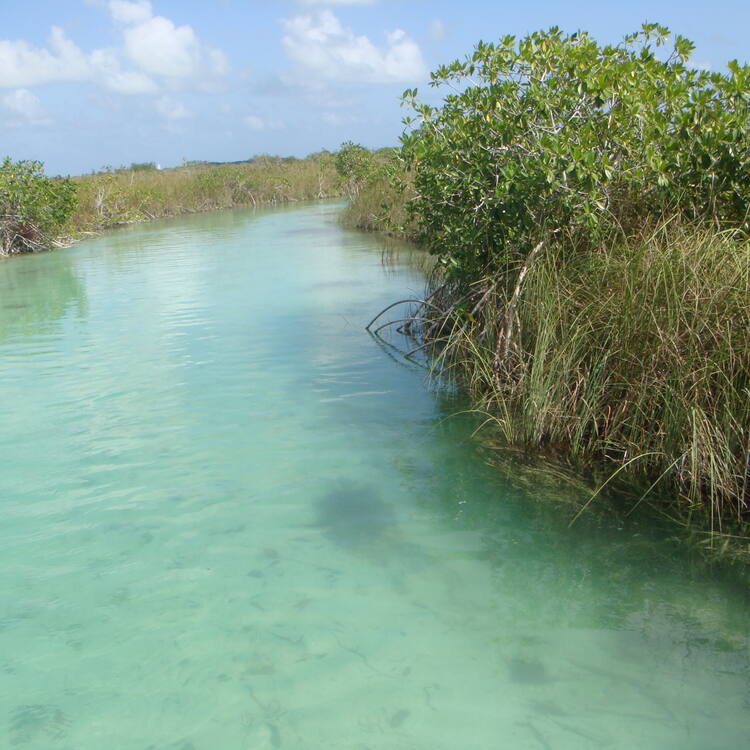
 View photos from OUR PLACE the World Heritage collection
View photos from OUR PLACE the World Heritage collection
